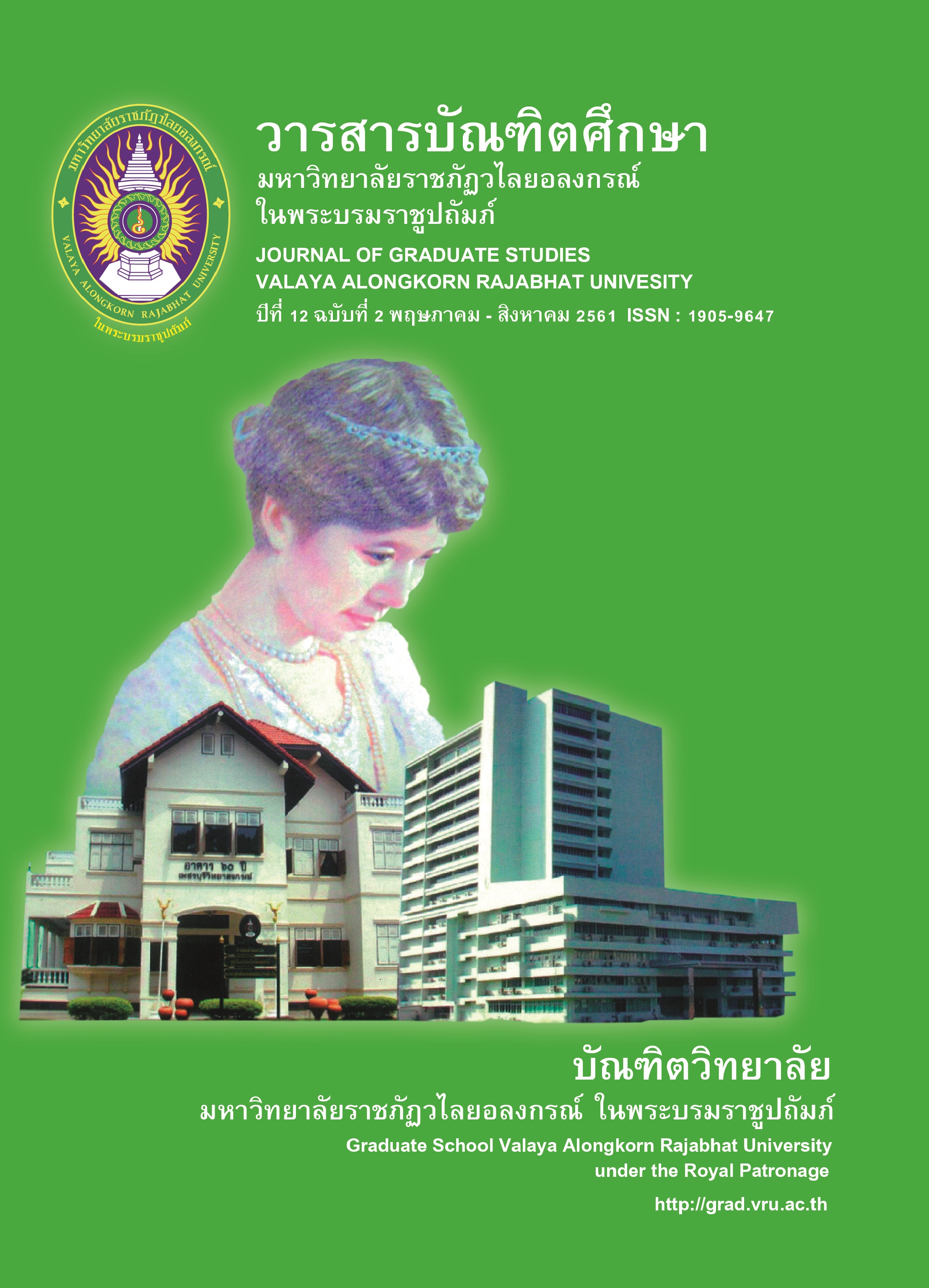THE QUALITY OF LIFE OF CHILDREN WITH COCHLEAR IMPLANTATION: PARENTAL PERSPECTIVES AND EXPERIENCES
Main Article Content
Abstract
The objectives of this research were to study the quality of life of children with cochlear implants and to compare the quality of life of the children who received cochlear implants at different ages in according to the perspectives and experiences of their parents. The target group of this study were 72 parents of children with cochlear implantation from Cochlear Implant Community of Thailand. The data were collected from parents of these children by using a questionnaire. The quantitative data were analyzed by descriptive statistics includes frequency, percentage, mean and standard deviation, and qualitative data were analyzed by content analysis.
The result of research revealed that:
- The total score as well as the score from each aspect of quality of life of children with cochlear implants from the perspectives and experiences of their parents were found at high level.
- There was a difference on the quality of life of children who received cochlear implants at different ages. Children who received cochlear implants at the age of between 1 to 5.6 years old have higher overall quality of life after cochlear implants than children who received cochlear implants at the age between 5.7 to 10.6 years old and children who received cochlear implants at the age more than 10.7 years old respectively.
Article Details
บทความทุกเรื่องได้รับการตรวจความถูกต้องทางวิชาการโดยผู้ทรงคุณวุฒิ ทรรศนะและข้อคิดเห็นในบทความวารสารบัณฑิตศึกษา มหาวิทยาลัยราชภัฏวไลยอลงกรณ์ ในพระบรมราชูปถัมภ์ มิใช่เป็นทรรศนะและความคิดของผู้จัดทำจึงมิใช่ความรับผิดชอบของบัณฑิตวิทยาลัย มหาวิทยาลัยราชภัฏวไลยอลงกรณ์ ในพระบรมราชูปถัมภ์ กองบรรณาธิการไม่สงวนสิทธิ์การคัดลอก แต่ให้อ้างอิงแหล่งที่มา
References
เกยูร วงศ์ก้อม. (2547). การจัดการศึกษาสำหรับเด็กที่มีความบกพร่องทางการได้ยิน. กรุงเทพมหานคร: มหาวิทยาลัยราชภัฏสวนดุสิต.
เกียรติยศ โคมิน. (2551). ประสาทหูเทียมประตูเปิดสู่ชีวิตที่มีเสียง. สืบค้นจาก https://www.hopetohear.net/special_story1_ci_doctor.html.
คณะกรรมการส่งเสริมและพัฒนาคุณภาพชีวิตคนพิการแห่งชาติ. (2553). แผนพัฒนาคุณภาพชีวิตคนพิการแห่งชาติ ฉบับที่ ๔ พ.ศ. ๒๕๕๕-๒๕๕๙. กรุงเทพมหานคร: โรงพิมพ์เทพเพ็ญวานิสย์.
นิศารัตน์ ศิลปะเดช. (2540). ประชากรกับการพัฒนาคุณภาพชีวิต. พิมพ์ครั้งที่ 2. กรุงเทพมหานคร: พิศิษฐ์การพิมพ์.
ปัณณ์พัฒน์ จันทร์สว่าง. (2556). ลูกมีความบกพร่องทางการได้ยิน (Children with Hearing Impairment). สืบค้นจาก https://taamkru.com/th.
ปริญญา หลวงพิทักษ์ชุมพล. (2553). การประเมินความสามารถทางการฟังและการพูดของเด็กหูหนวกที่ใช้เครื่องประสาทหูเทียม อายุ 1-5 ปี. กรุงเทพมหานคร: ห้างหุ้นส่วนจำกัด เอกการพิมพ์.
ปฤษฐพร กิ่งแก้ว และคณะ. (2552). โครงการประเมินเทคโนโลยีและนโยบายด้านสุขภาพร่วมกับแผนงาน สร้างเสริมสุขภาพคนพิการในสังคมไทย. การประเมินเทคโนโลยีการผ่าตัดฝังประสาทหูเทียม: มุมมองด้านเศรษฐกิจและสังคม. กรุงเทพมหานคร: บริษัท เดอะ กราฟิโกซิสเต็มส์ จำกัด.
เยาวพา เดชะคุปต์. (2528). กิจกรรมสำหรับเด็กก่อนวัยเรียน. กรุงเทพมหานคร: โอเดียนสโตร์.
ลลิตา เกษมสุวรรณ. (2559). ประสาทหูเทียม (Cochlear implant). สืบค้นจาก https://www.phyathai.com/medicalcenterdetail_article/16/250/PYT1/th.
วันทนีย์ โลหะประกิตกุล. (2559). ฝ่าความเงียบด้วยประสาทหูเทียม (ตอนที่ 4 และ ตอนจบ). สืบค้นจาก https://haamor.com/th.
ศูนย์ประสานงานการพัฒนาชนบทแห่งชาติ. (2532). คู่มือระบบบริหารการพัฒนาชนบท. กรุงเทพมหานคร: โรงพิมพ์ยูไนเต็ดโปรดักชั่น.
Archbold, S. M., Lutman, M. E., Gregory, S., O’Neill, C., and Nikolopoulos, T. P. (2002). Parents and their deaf child: their perceptions three years after cochlear implantation. Deafness and Education International. 4, 12- 40.
Archbold, S., Sach, T., O’Neill, C., Lutman, M., and Gregory, S. (2008). Outcomes from cochlear implantation for child and family: parental perspectives. Deafness and Education International. 10, 120-142.
Betty Loy, Andrea D. Warner-Czyz, Liyue Tong, Emily A. Tobey and Peter S. Roland. (2010). The children speak: An examination of the quality of life of pediatric cochlear implant users. Otolaryngology–Head and Neck Surgery. 142,247-253.
Huttunen, K., Rimmanen, S., Vikman, S., Virokannas, N., Sorri, M., Archbold, S., and Lutman, M. E. (2009). Parents’ views on the quality of life of their children 2-3 years after cochlear implantation. International Journal of Pediatric Otorhinolaryngology. 73, 1786-1794.
Schorr, E. A., Roth, F. P., and Fox, N. A. (2009). Quality of life for children with cochlear implants: perceived benefits and problems and the perception of single words and emotional sounds. Journal of Speech, Language, and Hearing Research. 52, 141–152.
Roshini, K., Warner-Czyz, A.D., Silver, C. H., Loy, B., and Tobey, E. A. (2015). American parent perspectives on quality of life in pediatric cochlear implant recipients. Ear and Hearing. 36, 269-278.
Zaidman-Zait, A., Curle, D., Jamieson, J. R., Chia, R., and Kozak, F. K. (2015). Cochlear implantation among deaf children with additional disabilities: parental perceptions of benefits, challenges, and service provision. Journal of Deaf Studies and Deaf Education. 20, 41-50.


